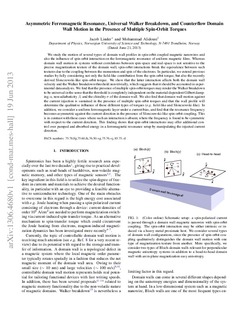| dc.contributor.author | Linder, Jacob | |
| dc.contributor.author | Alidoust, Mohammad | |
| dc.date.accessioned | 2017-10-26T14:02:29Z | |
| dc.date.available | 2017-10-26T14:02:29Z | |
| dc.date.created | 2013-10-16T15:09:46Z | |
| dc.date.issued | 2013 | |
| dc.identifier.citation | Physical Review B. Condensed Matter and Materials Physics. 2013, 88 (6), . | nb_NO |
| dc.identifier.issn | 1098-0121 | |
| dc.identifier.uri | http://hdl.handle.net/11250/2462435 | |
| dc.description.abstract | Measurement of the maximum blood flow velocity is the primary means for determining the degree of carotid stenosis using ultrasound. The current standard for estimating the maximum velocity is Pulsed Wave (PW) Doppler with manual angle correction, which is prone to error and interobserver variability. In addition, spectral broadening in the velocity spectra leads to overestimation of maximal velocities. In this work, we propose to combine two velocity estimation methods to reduce the bias and variability in maximum velocity measurements. First, the direction of the blood flow is estimated using an aliasing-resistant least squares vector Doppler technique. Then, tracking Doppler is performed on the same data, using the direction of the vector Doppler estimate as tracking direction. Simulations show that the method can estimate a maximum velocity of 2 m/s with a bias smaller than 5% for beam-to-flow angles between 20° and 75°, and that the primary source of error is inaccuracy in the flow direction estimate from vector Doppler. Simulations of complex flow in a carotid bifurcation demonstrated that the combined technique provided spectral velocity profiles corresponding well with the true maximum velocity trace, and that the bias originating from the directional estimate was within 5% for all spatial points. A healthy volunteer and a volunteer with carotid artery stenosis were imaged, showing in vivo feasibility of the method, for high velocities and with beam-to-flow angles varying throughout the cardiac cycle. | nb_NO |
| dc.language.iso | eng | nb_NO |
| dc.publisher | American Physical Society | nb_NO |
| dc.title | Asymmetric ferromagnetic resonance, universal Walker breakdown, and counterflow domain wall motion in the presence of multiple spin-orbit torques | nb_NO |
| dc.type | Journal article | nb_NO |
| dc.type | Peer reviewed | nb_NO |
| dc.description.version | acceptedVersion | nb_NO |
| dc.source.pagenumber | 12 | nb_NO |
| dc.source.volume | 88 | nb_NO |
| dc.source.journal | Physical Review B. Condensed Matter and Materials Physics | nb_NO |
| dc.source.issue | 6 | nb_NO |
| dc.identifier.doi | 10.1103/PhysRevB.88.064420 | |
| dc.identifier.cristin | 1058233 | |
| dc.description.localcode | This is the authors' accepted and refereed manuscript to the article. | nb_NO |
| cristin.unitcode | 194,66,20,0 | |
| cristin.unitname | Institutt for fysikk | |
| cristin.ispublished | true | |
| cristin.fulltext | postprint | |
| cristin.qualitycode | 2 | |
